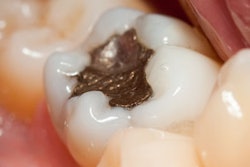
Editor's note: Second Opinion is a feature where dental leaders and opinion makers have a forum to express their positions on topics relevant to the practice of dentistry. DrBicuspid.com does not take an editorial position on these issues, but we do believe all sides of an issue should have an opportunity to be heard and discussed. We invite you to express your opinion in our Forums or submit a Second Opinion for consideration.
Dental amalgam is not a source of dietary mercury and should not be confused with methyl mercury, which people may be exposed to through dietary sources such as certain types of fish. At best, a mouth full of eight fillings provides 37 times less mercury per week than from a normal diet by dissolution (and a whopping 1620 times less by vapor delivery).1,2 This is based on half of the surface area of two average posterior quadrants (i.e., eight fillings) being amalgam and having 1.85 cm2 of surface area,3 and using the release rates from previously published studies.1,2 Further, elemental mercury is poorly absorbed, unlike methylmercury that is nearly fully bioavailable!
 J. Robert Kelly, DDS, MS, DMedSc, professor, Department of Reconstructive Sciences, Center for Biomaterials, University of Connecticut Health Center.
J. Robert Kelly, DDS, MS, DMedSc, professor, Department of Reconstructive Sciences, Center for Biomaterials, University of Connecticut Health Center.
In 2005, an informative dietary analysis was published of the French diet (soup to nuts one might say).4 These investigators purchased and analyzed nearly 5,000 foods from both regional and national sources over a two-year period. The average weekly intake of mercury was reported to be 9.7 µg per week. For the average Frenchman, this represents 0% of the provisional tolerable weekly intake (PTWI).4 Adding in dental mercury keeps this at 0% of the PTWI.
Since mercury from fillings is essentially well below "background," it comes as no surprise that fillings have never been found to have negative health effects (and that is not for a lack of looking -- lots of people have looked). As reported in 2006 in the Journal of the American Medical Association, two prospective clinical trials (the medical gold standard) of children receiving either amalgam or resin-based composite fillings found no differences in IQ, memory, attention, visuomotor function, nerve conduction, or kidney function in five years to seven years.6,7 What they did find was a 50% higher replacement rate for the tooth-colored stuff. Even in the Seychelles Islands, where mothers generally eat fish with every meal, the children were not found to have any negative neurodevelopmental outcomes as a function of their mothers having between 0 and 28 amalgam surfaces during pregnancy. Amalgam fillings on top of a high dietary load made no difference.7
“That dental amalgam fillings do not cause health problems has been independently assessed by groups focused on degenerative diseases.”
That dental amalgam fillings do not cause health problems has been independently assessed by groups focused on degenerative diseases, including the Alzheimer's Association, the National Multiple Sclerosis Society, and the Institute of Neurotoxicology and Neurological Disorders (autism). Further, many other organizations outside of dentistry have reviewed the scientific literature looking for any credible link between dental amalgam fillings and general health problems -- and have found none: the American Academy of Pediatrics, the U.S. Food and Drug Administration, the National Institutes of Health, the U.S. Public Health Service, the U.S. Centers for Disease Control and Prevention, the World Health Organization, and the European Commission. So the position of the ADA is universally matched by every credible scientific and medical analysis ever performed.
Wouldn't it be wonderful if dentists could prevent or cure multiple sclerosis, Alzheimer's, or autism? We simply cannot -- and should not pretend to have such powers. Dentists, and the ADA, have absolutely no vested interest financial or otherwise in dental amalgam -- other than it often represents the best material choice for our patients. There has never been a legislative or regulatory body in the U.S. that has banned amalgam, and many have examined the issue. There is simply no question that dental amalgam is a safe and effective restorative material!
J. Robert Kelly, DDS, MS, DMedSc, is a professor in the department of reconstructive sciences at the Center for Biomaterials at the University of Connecticut Health Center in Farmington, CT.
The comments and observations expressed herein do not necessarily reflect the opinions of DrBicuspid.com, nor should they be construed as an endorsement or admonishment of any particular idea, vendor, or organization.
Sources
- Okabe K. Mercury in the structure of dental amalgam. Dent Mater. 1987;3(1):1-18.
- Neme AL, Maxson BB, Linger JB, Abbott LJ. An in-vitro investigation of variables influencing mercury vapor release from dental amalgam. Oper Dent. 2002;27(1):73-80.
- Bourdiol P, Mioche L. Correlations between functional and occlusal tooth surface areas and food texture during natural chewing sequences in human. Arch Oral Biol. 2000;45(8):695-699.
- LeBlanc JC, Guérin T, Noël L, Calamassi-Tran G, Volatier JL, Verger P. Dietary exposure estimates of 18 elements from the 1st French Total Diet Study. Food Addit Contam. 2005;22(7):624-641.
- Bellinger DC, Trachtenberg F, Barregard L, et al. Neuropsychological and renal effects of dental amalgam in children: A randomized clinical trial. JAMA. 2006;295(15):1775-1783.
- DeRouen TA, Martin MD, Leroux BG, et al. Neurobehavioral effects of dental amalgam in children: A randomized clinical trial. JAMA. 2006;295(15):1784-1791.
- Watson GE, van Wijngaarden E, Love TM, et al. Neurodevelopmental outcomes at 5 years in children exposed prenatally to maternal dental amalgam: The Seychelles Child Development Nutrition Study. Neurotoxicol Teratol. 2013;39:57-62.



















